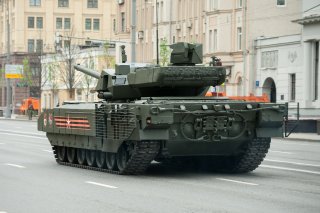Was the T-95 ‘Super-Tank’ Really Better than the Newer T-14 ‘Armata’?
The Object 195 project was incredibly ambitious.
Here’s What You Need to Remember: From all of the features above, the T-95 appears to be a far more powerful tank than the T-14. The T-14 has a less powerful primary and coaxial armament, has fewer sighting systems, and has similar armor. However, technology has advanced significantly since the cancellation of the T-95 project in 2010.
The history of Russian and Soviet armor is littered with prototypes of “super tanks” that promised armor and lethality far beyond any of their contemporaries. But at the end of the Cold War, the Soviet Union developed an actual prototype “super-tank” that if fielded would have outclassed every contemporary NATO tank: the T-95 (Object 195). Russia continued development of the project up until the 2010s, at which point it was abandoned in favor of the newer T-14 “Armata.”
But some Russian defense commentators proclaim to this day that the T-95 was the better tank. What made it so good? How does it stack up to the Armata?
The Object 195 project was incredibly ambitious. Design of the tank started in 1988, under the project name “Improving-88.” The idea was to create a tank that would outclass the majority of NATO armor to a similar degree to which German Tiger did to Soviet armor at its time of introduction.
As such, the tank was expected to have a longer effective range, be more survivable, and hit harder than any prior Soviet tank.
To attain superior survivability, the designers moved the three crew members into their own separate compartment in the hull, leaving the turret completely unmanned. While this design has since been adapted to the Armata, the T-95 utilized it first.
In addition to redesigning the crew compartment, the T-95 utilized the active-protection systems (APS), explosive reactive armor (ERA), and composite armor. The APS layout of the T-95 was directly copied on the Armata, with multiple “hard kill” launchers lining the bottom of the turret. Softkill systems were also installed on the T-95, though the exact capabilities are unknown. ERA on the T-95 was an early version of the heavy “Relikt” ERA, the follow on to “Kontakt-5.” While Relikt is common on many modern Russian tanks, it was originally developed for the T-95.
The turret of the T-95 was also taller, which allows it to have a greater gun depression and elevation range. Soviets traditionally have been willing to sacrifice gun depression to have more squat turrets, but the change on the T-95 suggests that the designers may have come around to the Western “hull down” philosophy due to putting the crew in the hull.
Armament wise, the T-95 mounted a 152mm 2A83 smoothbore gun. Statistics for the gun are nothing short of impressive, with a stated muzzle velocity of nearly 2,000 meters per second for APFSDS ammunition. Ammunition was also unified with 152mm howitzers, allowing the tank to shoot all kinds of artillery rounds, including possibly nuclear shells. Guided missiles were also developed for the gun to allow it to reach out even further.
The coaxial armament of the T-95 was likewise increased. Most tanks mount a 7.62mm or 12.7mm machine gun as secondary armament, but the T-95 opted to mount a 2A42 30mm cannon. Mounting autocannons coaxial to tank guns has been done before, notably on the French AMX-30 series of tanks, but the T-95’s autocannon is one of the largest to be coaxially mounted and has a small range of independent motion.
Of course, a powerful gun is nothing without the ability to acquire the target at a longer distance. The T-95 features the usual thermal and optical sights with high levels of zoom but also has a dedicated radar gunsight mounted right above the barrel. The radar gunsight could be used in situations where the battlefield is filled with multispectral smoke which defeats both optical and thermal sights. The T-14 Armata is speculated to have a radar-sighting capability, but it does not appear to feature a dedicated radar gunsight like the T-95.
The T-95 was said to also have significant battlefield networking capabilities to leverage the 152mm gun’s range. The T-95 was designed to be able to engage targets spotted by drones or by other units over the horizon.
From all of the features above, the T-95 appears to be a far more powerful tank than the T-14. The T-14 has a less powerful primary and coaxial armament, has fewer sighting systems, and has similar armor. However, technology has advanced significantly since the cancellation of the T-95 project in 2010. The T-14 is said to feature extensive jamming capabilities against enemy missiles and radar, beyond the “Shtora-2” mounted on the T-95, including possibly chaff and flare launchers.
Charlie Gao studied political and computer science at Grinnell College and is a frequent commentator on defense and national-security issues.
This article is being republished due to reader interest.
Image: Wikimedia Commons.

